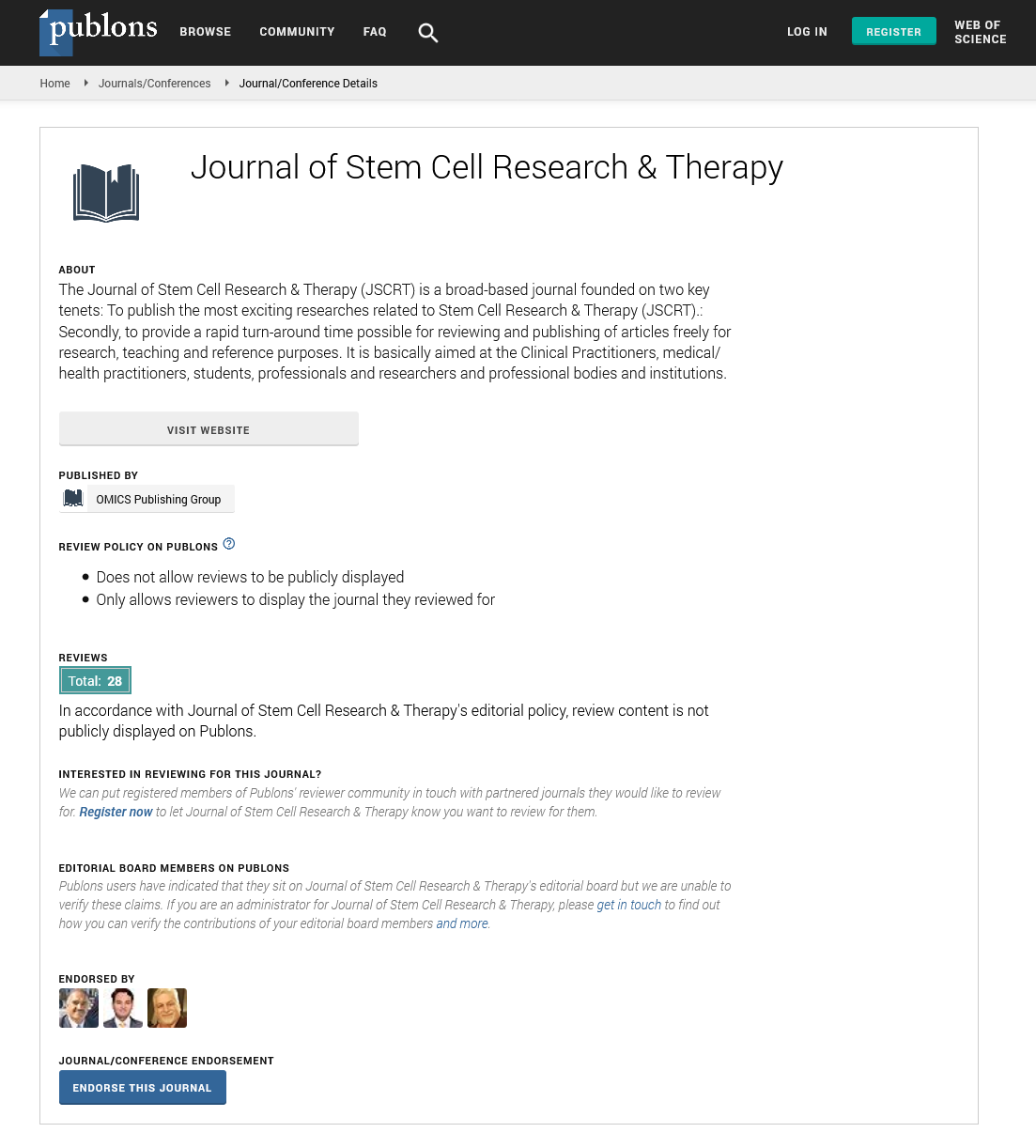Indexed In
- Open J Gate
- Genamics JournalSeek
- Academic Keys
- JournalTOCs
- China National Knowledge Infrastructure (CNKI)
- Ulrich's Periodicals Directory
- RefSeek
- Hamdard University
- EBSCO A-Z
- Directory of Abstract Indexing for Journals
- OCLC- WorldCat
- Publons
- Geneva Foundation for Medical Education and Research
- Euro Pub
- Google Scholar
Useful Links
Share This Page
Journal Flyer

Open Access Journals
- Agri and Aquaculture
- Biochemistry
- Bioinformatics & Systems Biology
- Business & Management
- Chemistry
- Clinical Sciences
- Engineering
- Food & Nutrition
- General Science
- Genetics & Molecular Biology
- Immunology & Microbiology
- Medical Sciences
- Neuroscience & Psychology
- Nursing & Health Care
- Pharmaceutical Sciences
Perspective - (2022) Volume 12, Issue 6
Neural Stem Cell Development and Cell Adhesion Molecules
Received: 01-Jun-2022, Manuscript No. JSCRT-22-17272; Editor assigned: 06-Jun-2022, Pre QC No. JSCRT-22-17272(PQ); Reviewed: 20-Jun-2022, QC No. JSCRT-22-17272; Revised: 28-May-2022, Manuscript No. JSCRT-22-17272(R); Published: 05-Jul-2022, DOI: 10.35248/2157-7633.22.12.540
Description
Different neural cell types emerge and migrate in a precise temporospatial manner in the mammalian Central Nervous System. Neurogenesis peaks at Embryonic day 14 (E14) and declines at Embryonic day 18 (E18) in the mouse brain, when neurons start appear around Embryonic day 12 (E12). The quantity of astrocytes begins to develop at E18 and peaks in the neonatal period. Oligodendrocytes are produced after birth when neurogenesis has mostly stopped.
In vitro cultured neural precursors demonstrated improved neuronal differentiation along with decreased astrogliogenesis and unaltered oligodendrocyte genesis, regardless of whether they were co-grown with fibroblasts overexpressing L1 or cultured on substrate coated with L1. Additional research on several neuronal subtypes that separated from NS/PCs reveals that L1 suppresses cholinergic neuron differentiation but increases GABAergic neuron differentiation.
Ectopic L1 expression in NS/PCs or overexpression of L1 on ESC-derived neural precursors improves neuronal development but inhibits astrocytic differentiation in an in vitro culture system. When GABAergic neurons were transplanted into striatum that had been damaged, L1 overexpression also caused a greater yield of these neurons. The SVZ, hippocampus, and rostral migratory stream are among the adult CNS's neurogenic areas that express PSA-NCAM, another significant IgSF CAM that has been identified as a neural precursor marker (RMS).
The development of the mouse brain depends on the migration and differentiation of neural precursors under the control of Polysialic Acid (PSA). In the OB, where they differentiate into interneurons that do not express PSA, SVZ precursors travel along the RMS. It's interesting to note that migratory failure and premature differentiation occur when PSA is specifically deleted from SVZ precursors using Endoneuraminidase-N (Endo N). Nestin-positive cells do not migrate and do not acquire the characteristics of neuronal cells, such as long neurites. These cells also exhibit positive Tyrosine Hydroxylase (TH). Further research showed that cell-cell contact, which is made possible by NCAM activating p59fyn and MAPK p44/42 activation, is necessary for PSA-dependent differentiation.
After PSA was removed using a double-knockout strategy for the PSA synthases ST8SiaII and ST8SiaIV, there were more astrocytes that were positive for the Glial Fibrillary Acidic Protein (GFAP), both in vitro and in vivo. TAG-1 interacts with the amyloid precursor protein to suppress neurogenesis (APP). When TAG-1 and APP connect to one another, the APP Intracellular Domain (AICD) is released, which causes the APP signalling pathway to be activated and negatively inhibit neurogenesis. These two molecules are co-localized in the neurogenic niche and neural progenitors. Fe65 has been discovered to be a downstream component of TAG-1-APP signalling during the control of neurogenesis and is expressed in the neurogenic VZ as well.
β4-integrin plays an important role in NS/PC differentiation. Under in vitro culture system, reduced of endogenous β4-integrin inhibits cell differentiation and decreases of FGFR2 action, while overexpression of β4-integrin in NS/PCs promotes differentiation. The FNIII domain 6-8 of ECM molecule tenascin-R, through interactions with β1-integrin, stimulates astrocytic differentiation, while stopping differentiation into neurons and oligodendrocytes; Contrariwise, Epidermal Growth Factor Like (EGFL) domain of tenascin-R promotes neuronal differentiation, while reducing differentiation into astrocytes and oligodendrocytes, through interactions with β1-integrin that can be inhibited with application of β1-integrin antibody.
Conclusion
The parts of cadherins on neural diversity are still not well assumed. Although neural differentiation appears to occur normally in N-cadherin-deficient mice, a recent study knocking down N-cadherin expression by in utero eletroporation caused an enhanced neuronal differentiation, likely through β-catenin signaling as it can be saved by presenting a stabilized active form of β-catenin.
Citation: Boirel M (2022) Neural Stem Cell Development and Cell Adhesion Molecules. J Stem Cell Res Ther. 12:540.
Copyright: © 2022 Boirel M. This is an open-access article distributed under the terms of the Creative Commons Attribution License, which permits unrestricted use, distribution, and reproduction in any medium, provided the original author and source are credited.

